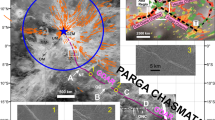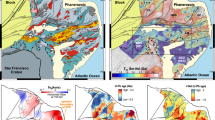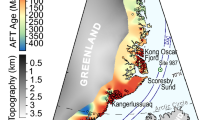Abstract
The timing of formation of the Grand Canyon, USA, is vigorously debated. In one view, most of the canyon was carved by the Colorado River relatively recently, in the past 5–6 million years. Alternatively, the Grand Canyon could have been cut by precursor rivers in the same location and to within about 200 m of its modern depth as early as 70–55 million years ago. Here we investigate the time of formation of four out of five segments of the Grand Canyon, using apatite fission-track dating, track-length measurements and apatite helium dating: if any segment is young, the old canyon hypothesis is falsified. We reconstruct the thermal histories of samples taken from the modern canyon base and the adjacent canyon rim 1,500 m above, to constrain when the rocks cooled as a result of canyon incision. We find that two of the three middle segments, the Hurricane segment and the Eastern Grand Canyon, formed between 70 and 50 million years ago and between 25 and 15 million years ago, respectively. However, the two end segments, the Marble Canyon and the Westernmost Grand Canyon, are both young and were carved in the past 5–6 million years. Thus, although parts of the canyon are old, we conclude that the integration of the Colorado River through older palaeocanyons carved the Grand Canyon, beginning 5–6 million years ago.
This is a preview of subscription content, access via your institution
Access options
Subscribe to this journal
Receive 12 print issues and online access
$259.00 per year
only $21.58 per issue
Buy this article
- Purchase on Springer Link
- Instant access to full article PDF
Prices may be subject to local taxes which are calculated during checkout




Similar content being viewed by others
References
Wernicke, B. The California River and its role in carving Grand Canyon. Geol. Soc. Am. Bull. 123, 1288–1316 (2011).
Flowers, R. M., Wernicke, B. P. & Farley, K. A. Unroofing, incision, and uplift history of the southwestern Colorado Plateau from apatite (U-Th)/He thermochronometry. Geol. Soc. Am. Bull. 120, 571–587 (2008).
Flowers, R. M. & Farley, K. A. Apatite 4He/3He and (U-Th)/He evidence for an ancient Grand Canyon. Science 338, 1616–1619 (2012).
Flowers, R. M. & Farley, K. A. Response to comments on apatite 4He/3He and (U–Th)/He evidence for an ancient Grand Canyon. Science 340, 143–146 (2013).
Blackwelder, E. Origin of the Colorado River. Geol. Soc. Am. Bull. 45, 551–565 (1934).
McKee, E. D. & McKee, E. H. Pliocene uplift of the Grand Canyon region: Time of drainage adjustment. Geol. Soc. Am. Bull. 83, 1923–1932 (1972).
Lucchitta, I. History of the Grand Canyon and the Colorado river in Arizona. Ariz. Geol. Soc. Dig. 17, 701–718 (1989).
Karlstrom, K. E. et al. Model for tectonically driven incision of the less than 6 Ma Grand Canyon. Geology 36, 835–838 (2008).
Lee, J. P. et al. New thermochronometric constraints on the Tertiary landscape evolution of Central and Eastern Grand Canyon, Arizona. Geosphere 9, 21–36 (2013).
Ketcham, R. A. et al. Improved modeling of fission-track annealing in apatite. Am. Min. 92, 799–810 (2007).
Farley, K. A. Helium diffusion from apatite: General behavior as illustrated by Durango fluorapatite. J. Geophys. Res. Solid Earth 105, 2903–2914 (2000).
Shuster, D. L. & Farley, K. A. 4He/3He thermochronometry. Earth Planet. Sci. Lett. 217, 1–17 (2004).
Reiners, P. W. & Ehlers, T. A. Low-temperature thermochronology: Techniques, interpretations, and applications. Rev. Mineral. Geochem. 58, 620 (2005).
Braun, J. et al. Quantifying rates of landscape evolution and tectonic processes by thermochronology and numerical modeling of crustal heat transport using PECUBE. Tectonophysics 524–525, 1–28 (2012).
Kelley, S. A., Chapin, C. E. & Karlstrom, K. E. Laramide cooling histories of Grand Canyon, Arizona, and the Front Range, Colorado, determined from apatite fission-track thermochronology. Grand Canyon Assoc. Mon. 12, 37–46 (2001).
Dumitru, T. A., Duddy, I. R. & Green, P. F. Mesozoic-Cenozoic burial, uplift, and erosion history of the west-central Colorado Plateau. Geology 22, 499–502 (1994).
Polyak, V., Hill, C. & Asmerom, Y. Age and evolution of the Grand Canyon revealed by U-Pb dating of water table–type speleothems. Science 319, 1377–1380 (2008).
Billingsley, G. H. Volcanic rocks of the Grand Canyon region. Grand Canyon Assoc. Mon. 12, 223–232 (2001).
Lucchitta, I., Holm, R. F. & Lucchitta, B. K. A Miocene river in northern Arizona and its implications for the Colorado River and Grand Canyon. GSA Today 21, 4–10 (2011).
McKee, E. D., Wilson, R. F., Breed, W. J. & Breed, C. S. Evolution of the Colorado River in Arizona. Museum Nor. Ariz. Bull. 44, 1–67 (1967).
Young, R. A. Geomorphic, structural, and stratigraphic evidence for Laramide uplift of the southwestern Colorado Plateau margin in northwestern Arizona. Utah Geol. Assoc. Pub. 30, 227–237 (2001).
Young, R. A. & Hartman, J. H. Early Cenozoic rim gravel of Arizona—Age, distribution and geologic significance. US Geol. Surv. OFR 2011–1210, 274–280 (2011).
Young, R. A. Brief Cenozoic geologic history of the Peach Springs Quadrangle and Hualapai Plateau, Mohave County, Arizona (Hualapai Indian Reservation).Ariz. Geol. Surv. Cont. Rep. CR-11-O, 1–28, geologic map and cross section (2011)
Strahler, A. N. Geomorphology and structure of the West Kaibab fault zone and Kaibab Plateau, Arizona. Geol. Soc. Am. Bull. 59, 513–540 (1948).
Young, R. A. in Mesozoic-Cenozoic Tectonic Evolution of the Colorado River region, California, Arizona, and Nevada (eds Frost, E. G. & Martin, D. L.) 29–39 (Cordilleran Publishers, 1982).
Huntoon, P. W., Billingsley, G. H. & Clark, M. D. Geologic map of the Hurricane fault zone and vicinity, western Grand Canyon, Arizona. Grand Canyon Assoc. 1, 48000 (1981).
Karlstrom, K. E. et al. 40Ar/39Ar and field studies of Quaternary basalts in Grand Canyon and model for carving Grand Canyon: Quantifying the interaction of river incision and normal faulting across the western edge of the Colorado Plateau. Geol. Soc. Am. Bull. 119, 1283–1312 (2007).
Karlstrom, K. E. et al. Comment on: Apatite 4He/3He and (U–Th)/He evidence for an ancient Grand Canyon. Science 340, 143 (2013).
Young, R. A. AGU 28th Int. Geol. Cong. Field Trip T115/315 (American Geophysical Union, 1989)
Faulds, J. E., Price, L. M. & Wallace, M. A. Pre-Colorado River paleogeography and extension along the Colorado Plateau–Basin and Range boundary, northwest Arizona. Grand Canyon Assoc. Mon. 12, 93–99 (2001).
Lucchitta, I. Comment on apatite 4He/3He and (U–Th)/He Evidence for an ancient Grand Canyon. Science 340, 143 (2013).
Dorsey, R. J. et al. Chronology of Miocene-Pliocene deposits at Split Mountain Gorge, Southern California; A record of regional tectonics and Colorado River evolution. Geology 35, 57–60 (2007).
Ingersoll, R. V. et al. Detrital zircons indicate no drainage link between southern California rivers and the Colorado Plateau from mid-Cretaceous through Pliocene. Geology 41, 311–314 (2013).
Karlstrom, K. E. et al. Surface response to mantle convection beneath the Colorado Rocky Mountains and Colorado Plateau. Lithosphere 4, 3–22 (2012).
Farley, K. A., Wolf, R. A. & Silver, L. T. The effects of long alpha-stopping distances on (U–Th)/He ages. Geochim. Cosmochim. Acta 60, 4223–4229 (1996).
Flowers, R. M. et al. Apatite (U–Th)/He thermochronometry using a radiation damage accumulation and annealing model. Geochim. Cosmochim. Acta 73, 2347–2365 (2009).
Shuster, D. L., Flowers, R. M. & Farley, K. A. The influence of natural radiation damage on helium diffusion kinetics in apatite. Earth Planet. Sci. Lett. 249, 148–161 (2006).
Shuster, D. L., Cuffey, K. M., Sanders, J. W. & Balco, G. Thermochronometry reveals headward propagation of erosion in an alpine landscape. Science 332, 84–88 (2011).
Acknowledgements
This work was supported by NSF Grant EAR-1242028 from the Tectonics Program. Support for our whitewater raft facility was from the NSF EAR Instrumentation and Facilities Program. We acknowledge a research agreement with Grand Canyon National Park that has allowed river corridor access. Formal reviews by P. Reiners and R. Ingersoll, and an informal review by W. R. Dickinson, helped improve the paper.
Author information
Authors and Affiliations
Contributions
K.E.K. did the writing and data analysis. J.P.L., S.A.K., M.F., D.L.S. and J.W.R. did the thermochronology data analysis. R.S.C., L.J.C., R.A.Y., G.L. and L.S.B. did the geology data analysis.
Corresponding author
Ethics declarations
Competing interests
The authors declare no competing financial interests.
Supplementary information
Supplementary Information
Supplementary Information (PDF 1822 kb)
Rights and permissions
About this article
Cite this article
Karlstrom, K., Lee, J., Kelley, S. et al. Formation of the Grand Canyon 5 to 6 million years ago through integration of older palaeocanyons. Nature Geosci 7, 239–244 (2014). https://doi.org/10.1038/ngeo2065
Received:
Accepted:
Published:
Issue Date:
DOI: https://doi.org/10.1038/ngeo2065
This article is cited by
-
Coupled influence of tectonics, climate, and surface processes on landscape evolution in southwestern North America
Nature Communications (2022)
-
Formation of the Huajiang Grand Canyon (southwestern China) driven by the evolution of a Late Pleistocene tiankeng
Acta Geochimica (2022)
-
A stress-rifting origin of Grand Canyon
Science Bulletin (2016)
-
Grand Canyon is not so ancient
Nature (2014)
-
River gorge eradication by downstream sweep erosion
Nature Geoscience (2014)



